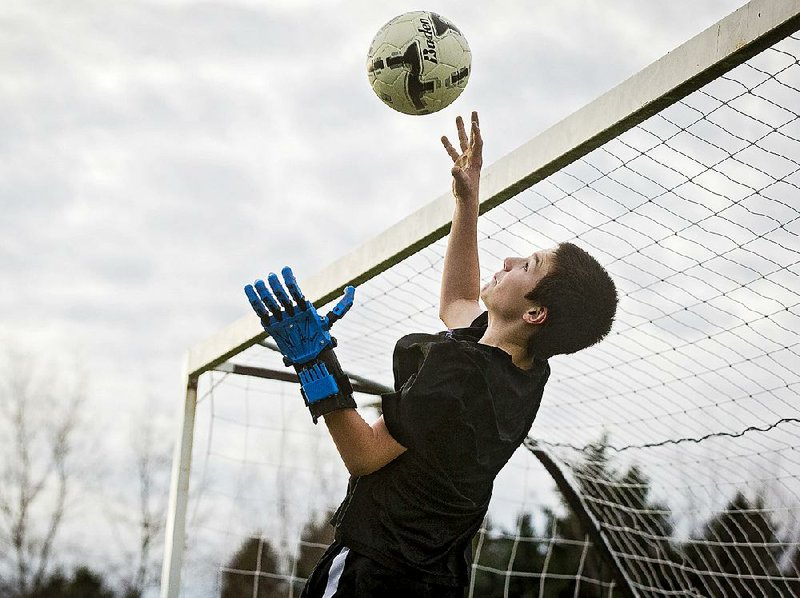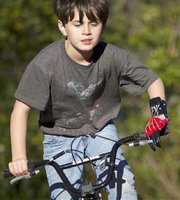Correction: This New York Times article published about 3-D printer prosthetic hands overestimated how many U.S. children suffer amputations from lawn mower injuries each year. The U.S. Consumer Product Safety Commission states that of 83,574 total people reporting any type of lawn mower injury in 2012 — the most recent annual report available — 5,127 were of children up to age 14. Exact numbers of amputations are unavailable; in one study, published by Trauma in 2005, of 85 children treated for lawn-mower-related injuries, 18 (21.2 percent) suffered amputations.
Dawson Riverman's parents tried to help him make the best of it.
Born without fingers on his left hand, Dawson struggled with basic tasks like tying his shoes or holding a ball. "God made you special in this way," his parents told him. But by age 5, Dawson was demanding tearfully to know why.
The Rivermans, of Forest Grove, Ore., could not afford a high-tech prosthetic hand for their son, and besides, such devices are rarely made for children. Then help arrived in the guise of a stranger with a three-dimensional printer.
He made a prosthetic hand for Dawson, in cobalt blue and black, and it did not cost his family a thing. Today the 13-year-old can ride a bike and hold a baseball bat. He hopes to play goalkeeper on his soccer team.
"He's realizing he can do things with two hands and not have to try to figure out how to do them," said his mother, Dawn Riverman.
The proliferation of 3-D printers has had an unexpected benefit: The devices, it turns out, are perfect for creating cheap prosthetics.
Children need them: One in 1,000 infants is born with missing fingers, and others lose fingers and hands to injury. Each year, about 9,000 children have an amputation as a result of lawn mower accidents alone.
State-of-the-art prosthetic replacements are complicated medical devices, powered by batteries and electronic motors, and they can cost thousands of dollars. Even if children are able to manage the equipment, young bodies grow too quickly to make the investment practical. So most go without, fighting to do with one hand what most people do with two.
VOLUNTEER FABRICATORS
E-nable, an online volunteer organization, aims to change that. Founded in 2013 by Jon Schull, the group matches children like Dawson in need of prosthetic hands and fingers with volunteers able to make them on 3-D printers. Designs may be downloaded into the machines at no charge, and members who create new models share their software plans freely with others.
The materials for a 3-D-printed prosthetic hand can cost as little as $20 to $50, and some experts say they work just as well, if not better, than much costlier devices.
They are not designed to look like replacement parts. One popular model, the Cyborg Beast, looks like a limb from a Transformer.
The fingers are closed by flexing the wrist, which pulls on cable "tendons." Move the wrist again, and the hand opens.
Other designs, the Raptor Hand and Talon Hand 2.X, do not suggest disability; they hint at comic-book superpowers. And they are not made to be hidden -- indeed, they can be fabricated in a variety of eye-catching fluorescent colors, or even made of glow-in-the-dark materials.
The hands are printed in pieces, which are assembled by volunteers, or by parents and children themselves.
More than 50 groups, such as Boy Scout and Girl Scout troops and schools such as Convent of the Sacred Heart in Manhattan, N.Y., have created hands for about 500 children.
"We have several thousand people on our site who are asking to help make hands," said Schull, a research scientist at the Rochester Institute of Technology. "What could be more rewarding than using your 3-D printer to make a hand for someone?"
IN ARKANSAS?
But E-nable doesn't have volunteer fabricators in Arkansas, says Melina Brown, whose volunteer duties at E-nable include matching donors and children.
"We don't appear to have any active registered volunteers in Arkansas right now," she said, adding that the organization would welcome some.
In the meantime, would E-nable work with families of Arkansas children who wanted a prosthetic?
"Absolutely! More often than not, our recipients are assisted by volunteers who are at a distance," she said. "For instance, my son's hand was made by Jeremy Simon in Illinois but we are in Alabama.
"With current technology, it is entirely possible to assist someone on the opposite
side of the world."
More information is at enablingthefuture.org.
20 HOURS TO PRINT
An online tool on the E-nable website, the "Handomatic," is used to fit the prosthesis to the child. A parent enters a series of measurements, and the tool spits out a custom design for the child that can be downloaded into the printer.
Each hand takes about 20 hours to print and another two or three hours to assemble. (Designs also can be downloaded from Thingiverse, a website run by MakerBot, a manufacturer of 3-D printers.) Assembly tutorials are available on YouTube.
It is not much harder than putting together a complex Lego kit, said Ivan Owen, one of the inventors of the 3-D printed hands, who made Dawson's hand.
"We released the designs into the public domain so there'd be no patent and everyone could do whatever they wanted with it," he said. "So many people contributed their time to improve on the initial design. I feel blessed."
A former school supplies salesman and special effects artist, Owen in December 2011 shared a video on YouTube of a giant puppet hand that he had made. That video was seen by Richard Van As, a carpenter in South Africa who had cut off some of his fingers with a table saw.
He asked Owen to help devise a prosthesis, and over two years, the pair came up with a workable design. A 3-D printer, they figured, would produce the prosthesis cheaply and easily.
When Van As learned of a boy in South Africa who also needed a prosthetic hand, they made one for him, too. The idea caught on.
"Sometimes at the right moment, there's momentum built up in an area," said Owen, who now runs a 3-D printing lab at the University of Washington at Seattle. "We removed the pebble under the boulder."
NOT RIGHT FOR EVERYONE
Some leading experts in 3-D design are collaborating with E-nable on improved prostheses for children. The hands are lightweight, less than a pound, but the fingers move together, not separately.
And they do not work for every child. Those with midarm amputations, for instance, usually must be seen by a professional prosthetist.
Many, though, are like Ethan Brown, 8, who was born with two fingers missing from his left hand. He wears a Cyborg Beast in black and red, his school colors.
"It looks even cooler than the picture," he said. "It looks like Ironman or Spider-Man."
He was once teased for his disability, said his mother, Melina Brown, of Opelika, Ala., who volunteers for E-nable. "Now he's different in a cool way, and the other kids say they want a new hand, too."
Health care providers are beginning to take note. In September, Johns Hopkins Hospital in Maryland and E-nable hosted the first 3-D printing conference involving the medical community, volunteers, recipients and manufacturers. The hospital has bought a 3-D printer and has begun printing free prosthetic devices for children.
"Anyone can get one of these hands -- it doesn't matter what insurance or health provider you have," said Dr. Albert Chi, an assistant professor of surgery at Johns Hopkins Medicine. "To be able to provide such a functional tool for anyone with congenital hand or limb loss, it kind of brings you to tears a little bit."
Celia Storey added information to this report.
ActiveStyle on 02/23/2015


